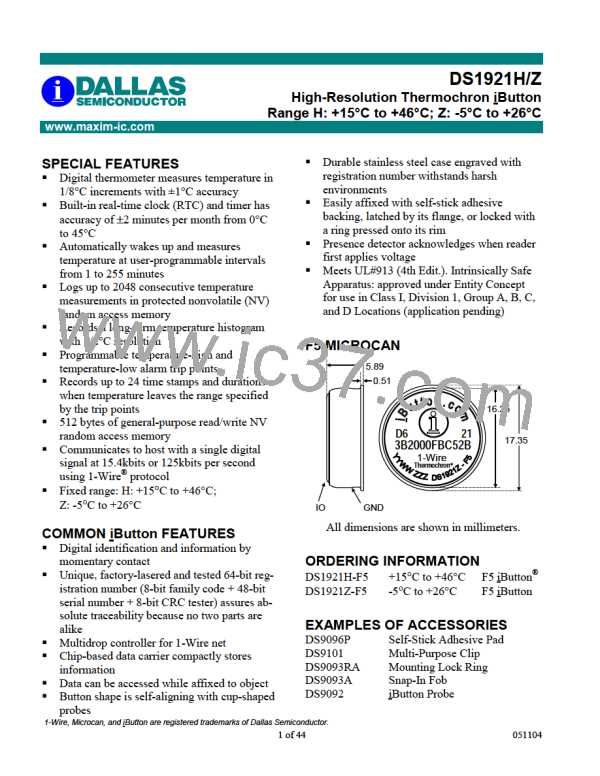DS1921H/Z
SAMPLE RATE
The content of the Sample Rate Register (address 020Dh) determines how many minutes the temperature
conversions are apart from each other during a mission. The sample rate may be any value from 1 to 255,
coded as an unsigned 8-bit binary number. If the memory has been cleared (Status Register bit MEMCLR
= 1) and a mission is enabled (Status Register bit EM = 0), writing a non-zero value to the Sample Rate
Register will start a mission. For a full description of the correct sequence of steps to start a temperature-
logging mission see sections Missioning or Missioning Example.
Sample Rate Register Map
ADDR
020Dh
b7
b6
b5
b4
b3
b2
b1
b0
Sample Rate
CONTROL REGISTER
The DS1921H/Z is set up for its operation by writing appropriate data to its special function registers that
are located in the register page. Several functions that are controlled by a single bit only are combined
into a single byte called Control Register (address 20Eh). This register can be read and written. If the
device is programmed for a mission, writing to the Control Register will end the mission and change the
register contents.
Control Register Bitmap
ADDR
020Eh
b7
b6
b5
0
b4
b3
b2
b1
b0
EMCLR
RO
TLS
THS
TAS
EOSC
EM
The functional assignments of the individual bits are explained in the table below. Bit 5 has no function.
It always reads 0 and cannot be written to 1.
Control Register Details
BIT DESCRIPTION
BIT(S)
DEFINITION
b7
This bit controls the crystal oscillator of the RTC. When set to logic 0,
the oscillator will start operation. When written to logic 1, the oscillator
will stop and the device is in a low-power data retention mode. This bit
must be 0 for normal operation. The RTC must have advanced at
least 1 second before a mission start will be accepted.
EOSC: Enable Oscillator
EMCLR: Memory Clear
Enable
b6
This bit needs to be set to logic 1 to enable the Clear Memory function,
which is invoked as a memory function command. The Time-Stamp,
Histogram Memory as well as the Mission Time Stamp, Mission
Samples Counter, Mission Start Delay and Sample Rate will be cleared
only if the Clear Memory command is issued with the next access to
the device. The EMCLR bit will return to 0 as the next memory function
command is executed.
b4
b3
This bit controls whether the DS1921H/Z will begin a mission as soon as
the sample rate is written. To enable the device for a mission, this bit
must be 0.
EM: Enable Mission
RO: Rollover
Enable/Disable
This bit controls whether the temperature logging memory is overwritten
with new data or whether data logging is stopped once the memory is
filled with data during a mission. Setting this bit to a 1 enables the
rollover and data logging continues at the beginning overwriting
previously collected data. Clearing this bit to 0 disables the rollover and
no further temperature values will be stored in the temperature logging
memory once it is filled with data. This will not stop the mission. The
device will continue measuring temperatures and updating the
histogram and alarm time stamps and durations.
9 of 44

 DALLAS [ DALLAS SEMICONDUCTOR ]
DALLAS [ DALLAS SEMICONDUCTOR ]